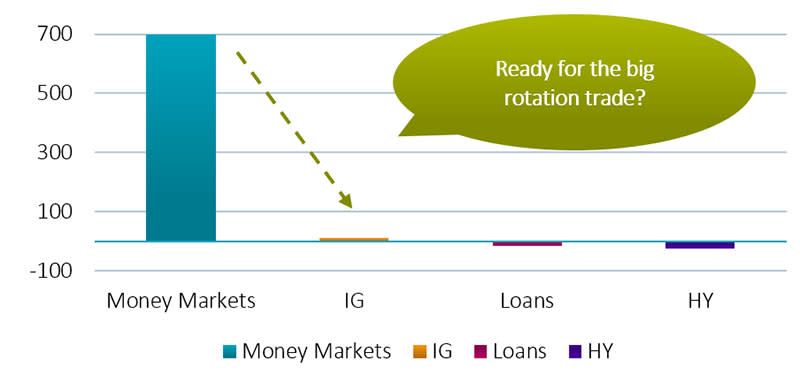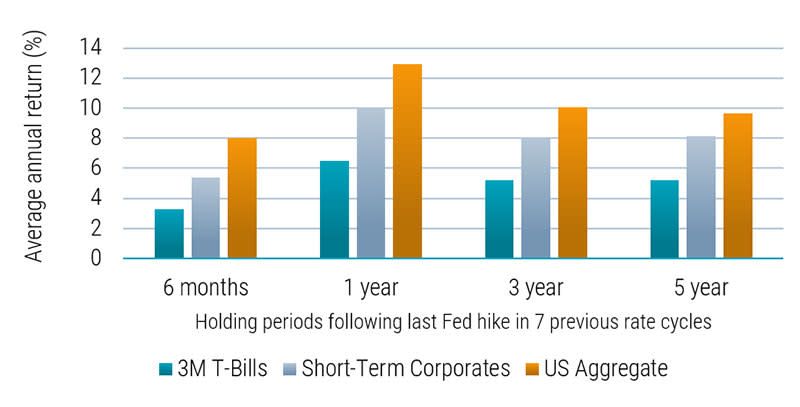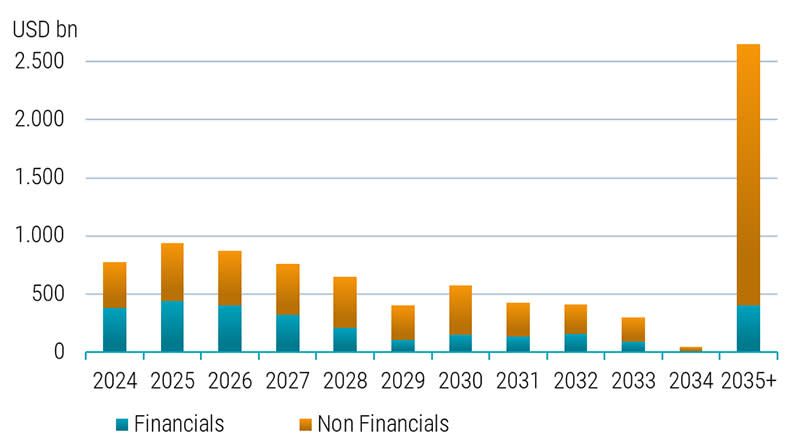
Robeco: Three reasons to move from cash to investment grade credit
As flows typically follow returns, we are now starting to see investors moving out of cash and into credits. This raises the question: Is this a smart move, or is cash still king in the current environment?
22.01.2024 | 05:13 Uhr
This
time last year many market participants were arguing that 2023 would be
a great year for bonds. Instead, interest rates continued to rise for
most of the year and flows into bond markets turned out to be
surprisingly modest. In fact, 2023 turned out to be the year of cash; we
saw record inflows in money market funds and short-dated treasuries as
investors were able to achieve 4-5% returns without any credit or
duration risk.
However, at
the end of 2023 and into the early stages of this year we have observed
the strong performance of bond markets as bond yields came down,
reflecting that markets were embracing the soft-landing scenario for the
US economy, i.e. a scenario of lower but not negative growth with
inflation cooling significantly.
Last year the global investment grade credit1market
delivered a total return of 9.1% (USD hedged) and 6.5% (EUR hedged) and
global high yield delivered a total return of 13.8% (USD hedged) and
11.2% (EUR hedged). This highlights the attractive return potential of
credit markets compared to money markets which delivered 5.2% (USD) and
3.3% (EUR) over the same period.
We
believe that investment grade credit and cross-over credit (BB-rated
credit) offer a compelling alternative to cash in the current
environment for three reasons.
1) Investment grade and BB-rated credit offer better return potential
First,
investment grade and BB-rated credit offer an attractive yield pick-up
over cash, especially in an environment where we expect central banks to
stop hiking and eventually start easing rates. Additionally, this
approach protects investors against future rate cuts by central banks,
which would immediately reduce the return on money market investments.
Within the high-quality credit space, the return prospects, particularly
for short-dated credit, look increasingly attractive as investors can
lock in higher yields than cash for the next 12 months with limited
interest rate or spread risk.
Figure 1 – Flows have started rotating from money markets

Source: Bloomberg, Morgan Stanley Research. Cumulative flows 2023 YTD (USD bn)
Money market funds and short-dated short term government bonds have been
viewed as a lucrative place to park cash with yields north of 4%. Yet
history has shown that these instruments have not been the best place to
be when central banks eventually pivot to policy easing. This is
illustrated in Figure 2 below which compares the performance of
short-dated corporates with money market investments and longer dated
aggregated bonds in periods following the last rate hike by the Fed.
„Investors can lock in higher yields than cash for the next 12 months“
On average, short-term corporates outperformed money markets by an
average 300 bps over different investment horizons (holding periods).
Longer duration bonds (US Aggregate) delivered higher returns, however,
they come with increased duration risk, meaning that longer duration
bonds would be more impacted if we continue to see interest volatility.
Our research2
has also indicated that shorter-maturity credits have a substantially
lower credit return volatility compared to longer-maturity credits, and
as a result, offer a higher risk-adjusted return. History also shows
that cash is an attractive place to be when the Fed begins to raise
rates, but once the central bank stops rate hikes, or begins to cut
rates, investors are forced to reinvest proceeds of matured bonds at
lower and lower rates. See our paper on short duration credits for more detail.
Figure 2 – Short dated bonds have historically outperformed cash

Source: Robeco, Bloomberg, September 2023
2) Investment grade credit stands up in recessionary environments
Second, investment grade and BB-rated companies should be able to perform well in a recession. We think that markets are too optimistic and that the probability of a recession is higher than markets are currently pricing in. As discussed in our recent credit quarterly outlook, history has shown that rate hiking cycles by central banks almost always lead to a recession, with the most recent exception being the 1990s. However, even in a recessionary environment with mild negative growth, investment grade credit and cross-over credit (BB-rated credit) offer a compelling alternative to cash.
There
are parts of the credit market that are more vulnerable if the economy
goes into a recession. Nevertheless, investment grade and BB-rated
companies will continue to do well even in an environment of moderate
negative growth. These companies have been more conservative with their
debt levels and therefore are able to weather the negative impact of a
recession on their profitability. Additionally, high interest rates will
be manageable for these companies as they also typically have more
longer-term debt outstanding, meaning there is no short-term risk of
having to refinance at higher rates.
„These companies have been more conservative with their debt levels“
This is also visible in Figure 3 below which shows the outstanding debt
for US investment grade companies (financials and corporates). A large
part of the outstanding maturities is for the year 2035 or beyond, so a
significant part of the outstanding debt for investment grade companies
only needs to be refinanced after ten years or beyond. Therefore, these
companies will not see higher rates translated into higher interest rate
costs any time soon.
This is a very different
scenario for lower rated (CCC) high yield companies where in the next
four years, more than 50% of outstanding debt will need to be
refinanced. These companies will most likely face a significant increase
in their interest rate expenses at a time when the economy is slowing
down. In this space of the credit market we expect negative credit
events as these companies will need to refinance their debt at much
higher rates. Consequently, this is a part of the market we want to
avoid in the current phase of the credit cycle.
Figure 3 - Refinancing risk is not a concern for investment grade companies

Source: BofA Global Research. USD bn equivalents
3) Better diversification of risks
The
third reason we encourage investors to move from cash to investment
grade and cross-over credit is that it allows for better diversification
of issuer risk. Typically, money market investments comprise more
concentrated holdings in a small number of issuers or counterparties.
While these issuers are of high credit quality, there can be significant
exposure to only a few issuers. Investing in high quality investment
grade and BB-rated credits allows for more diversification across
issuers. For example in our Global Credits – Short Maturity strategy we
invest in more than 130 different companies across the global investment
grade credit market.
„Investing in credit markets is about avoiding the losers“
Furthermore,
we would not advocate a passive approach to investing in credits as
this exposes investors to potentially lower quality companies with a
higher risk of default. Investing in credit markets is about avoiding
the losers through active management and fundamental bottom-up research.
As discussed in our recent podcast, this will be key in the current environment.
We
think investing in high quality credits is a smart move in today’s
dynamic market environment. Not only does it offer investors an
alternative to cash and short-dated government bonds, but as we approach
the end of one of the most aggressive rate hiking cycles by central
banks, investors can capitalize on opportunities and mitigate risks.
Footnotes
1
Indices quotes are the Bloomberg Global Aggregate Corporate Index (EUR
hedged and USD hedged), Bloomberg US Corporate High Yield + Pan Euro HY
ex Financials 2.5% Issuer Cap. (EUR hedged and USD hedged). Money
Market: ICE BofA ESTR Overnight Rate Index (EUR) and ICE BofA SOFR
Overnight Rate Index (USD)
2 Houweling, Van Vliet, Wang & Beekhuizen, 2015, ‘The Low-Risk Effect in Corporate Bonds’
Die Informationen auf der nachfolgenden Website der Robeco Deutschland, Zweigniederlassung der Robeco Institutional Asset Management B.V., richten sich ausschließlich an professionelle Kunden im Sinne von § 31a Abs. 2 Wertpapierhandelsgesetz (WpHG) wie beispielsweise Versicherungen, Banken und Sparkassen. Die auf dieser Website dargestellten Informationen sind NICHT für Privatanleger bestimmt und entsprechen nicht den für Privatanleger maßgeblichen gesetzlichen Bestimmungen.




Diesen Beitrag teilen: